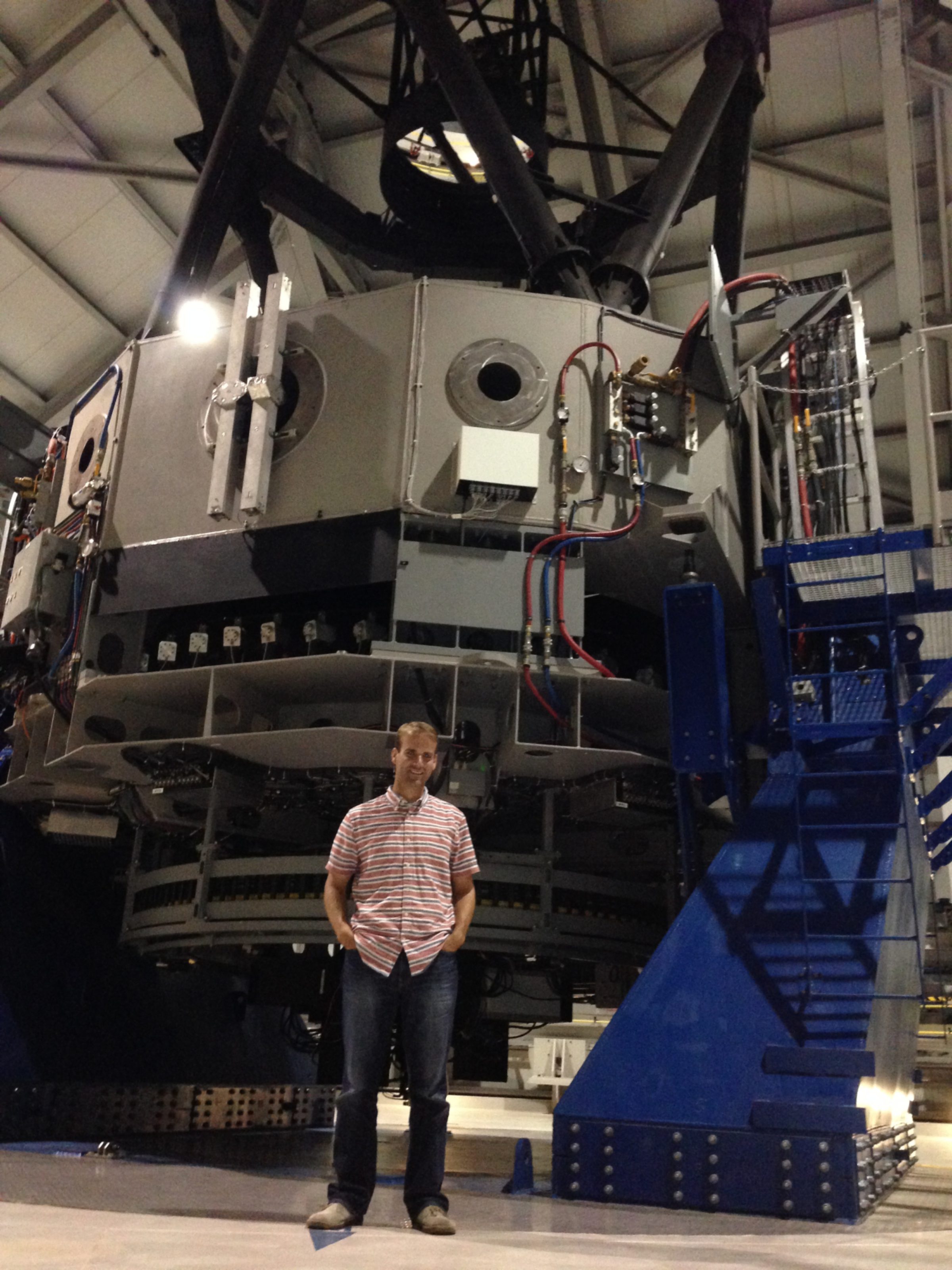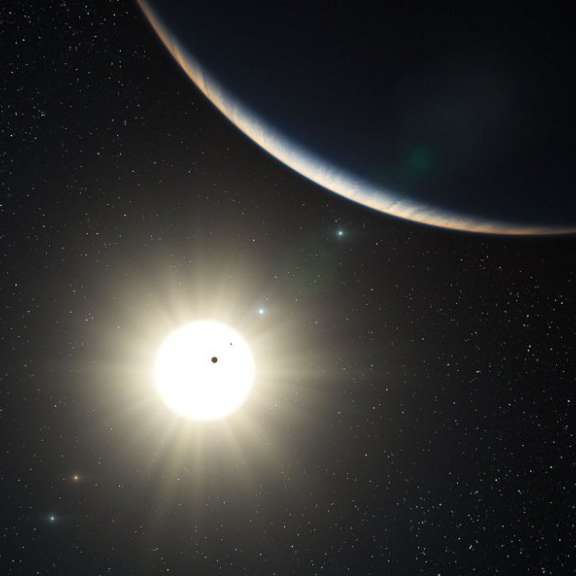Exoplanets Laser
Depending on the resolution of your screen, the period at the end of this sentence is probably just a couple pixels wide. Imagine taking one of those pixels and dividing it into a thousand strips. Zoom in on a handful of those strips. You're now looking at the distance a star's light spectrum shifts in one year, when that star is tugged on by an Earth-like exoplanet.
Our Exoplanets Projects
Since 2009, Planetary Society members have supported work by Debra Fischer, one of the world's top exoplanet researchers. These projects have greatly improved our ability to search for Earth-like exoplanets.
Planets tug on their stars as they orbit, giving the star a slight wobble. Astronomers can detect these wobbles over time with a telescope spectrograph, which splits starlight into its component wavelengths. An exoplanet with the same mass as Earth might only wobble its star by 10 centimeters per second, resulting in the thousandths-of-a-pixel shifts described above.
To detect these tiny shifts, new, high-resolution spectrographs are needed that can observe stars for years at a time. With funding from the National Science Foundation, the Yale University Exoplanet Group built EXPRES, the Extreme Precision Spectrograph. EXPRES was installed on the 4.3-meter Lowell Discovery Telescope at Lowell Observatory's Happy Jack site, located southeast of Flagstaff, Arizona. Under the direction of Dr. Debra Fischer, the new instrument supports Yale's 100 Earths project, which aims to find and characterize 100 Earth-like exoplanets.
Fischer's team needed to be sure that any shifts EXPRES detects are real, and not just variations in the way starlight is recorded at the observatory. They need an ultra-reliable calibration system. The Planetary Society pitched in to help fund the system, by raising $65,000 for a piece of equipment we called Exoplanets Laser. Yale postdoc Tyler McCracken led the effort to build and test the calibration system, which includes Exoplanets Laser.

EXPRES is calibrated using a frequency comb. A frequency comb is an artificially generated light spectrum that is imaged at the telescope alongside a star spectrum. The idea is for these artificial spectra to remain identical over years of observations. Computer algorithms can then use the artificial spectra as a sort-of ruler to measure tiny, long-term shifts in star spectra.
The frequency comb is generated using a Fabry–Pérot interferometer, named after the two physicists who invented it. For brevity, let's refer to it here as the FPI. The FPI has two, flat, parallel pieces of semi-transparent glass. The sides of the glass that face each other are mirrored.
White light is sent into the FPI. The light passes through first piece of glass, bounces back and forth between the mirrors, and passes through the second piece of glass. All of this bouncing back and forth takes the original band of solid white light and turns it into a series of repeating dots. These dots correspond to equally spaced frequencies along the electromagnetic spectrum—our frequency comb.

But there's a problem here. What if our FPI changes over time, and the frequency comb shifts? If that happened, our carefully measured star spectrum would have a faulty ruler, making it impossible to detect thousandths-of-a-pixel shifts.
The solution? We need one of the dots in our frequency comb to be super-precise, generated by something other than the FPI's white light. Then, we can center the FPI on this "known dot," which will make all the other dots in our frequency comb fall into place each and every time.
When scientists need to measure something with extreme precision, they often turn to atoms. Take, for instance, atomic clocks. When you bombard an atom with just the right wavelength of energy, its electrons absorb the energy and jump from their ground state orbits to higher, excited state orbits. Electrons don't like to live in their excited states for long, so they eventually jump back to their ground states, releasing the energy they absorbed. The wavelengths of energy that make different atoms maximize this absorb-and-release process are predictably constant—so constant that we define one second as the time it takes for a cesium atom to absorb or release 9,192,631,770 electromagnetic waves.
Similarly, we can use this electron-jumping regularity to tell us where to place the known dot in our FPI frequency comb. This is where Exoplanets Laser comes in. Exoplanets Laser is a high-end, professional-grade laser system built by TOPICA Photonics. It can be tuned to emit light at very specific wavelengths between 645 and 655 nanometers. Light from the laser is sent through a little container of iodine gas. Around the 650-nanometer mark, there are hundreds of wavelengths that cause the iodine atoms’ electrons to jump from their ground states to excited states. Using a wavemeter and a technique called Doppler-free spectroscopy, the laser is tuned to emit light at one of these very specific wavelengths.
The EXPRES spectrograph splits starlight into a range of wavelengths from blue to red. Our Exoplanets Laser is tuned to a specific wavelength near 650 nanometers corresponding to red light—right in the range of light EXPRES sees—so this is where we'll place the known dot that anchors our frequency comb. Once the laser is properly tuned, its light is sent through the FPI.
Unlike the broad-wavelength white light the FPI uses to generate the rows of dots for our frequency comb, the light from Exoplanets Laser is already tuned to a narrow, super-precise wavelength. As a result, the laser light coming through the FPI creates a single, constant dot that won't shift, since we don't expect the fundamental nature of atoms to change anytime soon. Once we have this known dot, the FPI's white light is turned on, et voilà! We have a perfectly aligned calibration spectrum centered on our known dot—accurate to an almost unfathomable scale. Every night, the laser will be tuned to the same, ultra-precise wavelength, giving us a precise calibration system that won't change over time.

The system we've just described is said to be "single-locked." The Exoplanets Laser is locked to the jumping iodine electrons, and the FPI frequency comb is locked to the Exoplanets Laser. In early 2015, this single-locked system was tested using the CHIRON spectrometer (another Yale Exoplanets Group project) on the 1.5-meter telescope at the Cerro Tololo Inter-American Observatory (CTIO) in northern Chile.
After that, Fischer and McCracken installed the calibration system on EXPRES at the Lowell Discovery Telescope in Arizona. But before they did that, they refined the system further. The single-locked system still had a few single points of failure. What if the spectrometer reads the excited iodine electrons incorrectly? What if the Exoplanets Laser tells us it's locked to the iodine wavelength when it really isn't?
To remove these uncertainties, the final calibration system uses three, separate single-locked systems. The entire process described above will be duplicated three times: three Exoplanets Lasers, three iodine cells, three spectroscopes, three FPIs, and three frequency combs. We call the result a "triple-locked" system. Remember, 650 nanometers is just one of the frequencies at which iodine electrons get excited. The additional two Exoplanets Lasers were tuned to prominent iodine wavelengths on opposite sides of the 650 mark. This created three known dots with three overlapping frequency combs. If one of the lasers or spectrometers acts up, the frequency combs will fall out of sync with one another, and the astronomers watching for star wobbles will know their spectra ruler has a problem.
There's also a more practical reason for using a triple-locked system: EXPRES can record accurate starlight data with just two frequency combs. Since observatories tend to be in remote areas (the Lowell Discovery Telescope sits on a 7,500-foot mountain peak, 40 miles from Flagstaff, Arizona), it can take days or even weeks to fix faulty equipment. With a triple-locked system, the system can continue to operate with two calibration units while the third awaits repairs.
Yale's triple-locked calibration system is the first of its kind. And after being installed on EXPRES, the Lowell Discovery Telescope became one of the most precise exoplanet-hunting instruments in the entire world. At The Planetary Society, we're excited to have contributed to such cutting-edge research.


 Explore Worlds
Explore Worlds Find Life
Find Life Defend Earth
Defend Earth


